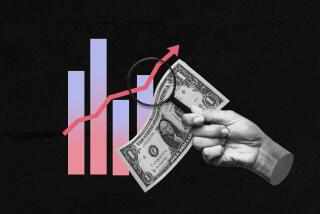Family Income Climbs, but Not Among Blacks
WASHINGTON — Family and individual income continued to increase in 1987 and reached historic highs in inflation-adjusted terms, the Census Bureau reported Wednesday. But for the first time since the 1982 recession, family income for blacks declined and the percentage of blacks in poverty increased slightly.
The mixed result emerged from the bureau’s annual accounting of before-tax income for Americans and its annual estimate of households below the theoretical poverty level--$11,611 last year.
The bureau reported that per capita income, generally considered the most reliable indicator of a nation’s standard of living, increased 1.6% to $12,287 last year, the highest ever in real terms and the fourth consecutive new high in this category.
At the same time, the poverty rate for the nation as a whole was virtually unchanged after steady declines since 1983. The percentage of Americans in poverty, 13.5%, remained significantly above the most recent low point of 11.4% reached in 1978.
Political Rhetoric
In recent years, the annual census report has generated considerable political rhetoric, and it is expected to do so even more this year with the presidential election only two months away.
In California, where President Reagan is vacationing, spokesman Marlin Fitzwater said the figures provide “further evidence that the most effective means of improving the life of Americans is a strong, productive economy. We think this is a good report.” It documents “a continuing rising income and reflects a growing, strong economy,” he said.
But, he added, the increase in poverty among blacks “obviously is disappointing.”
To Robert Greenstein, a Carter era official who now heads the Center on Budget and Policy Priorities, a liberal-oriented research group, the news was mostly bad. “The economic recovery is leaving many Americans behind,” he said in a statement, pointing especially to the increase in poverty among blacks, the first since 1983.
While family income increased approximately 1% for all families, for blacks and Latinos it declined by a trace amount. The poverty rate for the population at large was virtually unchanged at 13.5%, compared to 13.6% in 1986, but for blacks it increased significantly from 31.1% to 33.3% It increased slightly for Latino families but whites below the poverty level dropped from 11% to 10.5%.
Median Family Income
Median family income, which in recent years has been depressed by an increase in female-headed households and declining family size, hit a historic high of $30,853--surpassing the previous peak of $30,820 in inflation-adjusted dollars reached in 1973.
Both per capita and family income have climbed steadily since 1982 after nearly a decade of uncertainty and decline caused by high inflation and recession.
William P. Butz, Census Bureau associate director for demographic fields, stressed the “mixed message” and “complexity” of the question of measuring the economic well-being of a huge, diverse population, using a sampling of about 62,000 households.
He said it is premature to consider one year’s data a trend, and noted that between the recession trough of 1982 and 1987 black family income increased 13%, while among whites it increased 11.4%.
Butz also stressed that a point often cited by liberal economists--that the poorest segment of the population receives an ever smaller share of national income--could have been cited at any time over the last 20 years.
In 1967, the year when the nation’s postwar income distribution achieved its greatest “equality,” the poorest fifth of the population received 5.5% of the nation’s money income before taxes, while the richest fifth received 42.8%. In 1987, by contrast, the poorest received 4.6% and the richest 43.7%. Those are the same shares as in 1986, possibly a sign that the 20-year trend toward a growing gap may be slowing, some economists said.
Children in Poverty
The report reflected a similar plateau for the proportion of children in poverty. The 1987 level was 20%, compared to 16% in 1978 and 21.8% in 1983.
The report tracked a steady but slow march upward in women’s earnings compared to men’s. In 1987 women earned 65% of what men earned in all jobs, compared to 62% in 1982. Median earnings of full-time women workers hit an all-time high of $16,909 last year, compared to $26,008 for men.
The report offered one substantive hint on why the poorest fifth of the population, increasingly burdened by a growing percentage of female-headed households, has been getting steadily poorer for 20 years: Jobs are increasingly scarce and low-paying for poorly educated workers.
Families whose chief earner had only a grade school education earned a median of $14,550 in 1987--5.7% less than the year before--while families whose chief earner had one to three years of college earned a median of $54,490--2.6% more than the year before.
In addition, the number of families in poverty who were employed at all declined in 1987. Only 47.2% worked at all in 1987, less than 15% of them in full-time, year-round jobs. In 1986, the percentage employed was 50.1% and 16.7% respectively.
More to Read
Get the L.A. Times Politics newsletter
Deeply reported insights into legislation, politics and policy from Sacramento, Washington and beyond. In your inbox three times per week.
You may occasionally receive promotional content from the Los Angeles Times.










